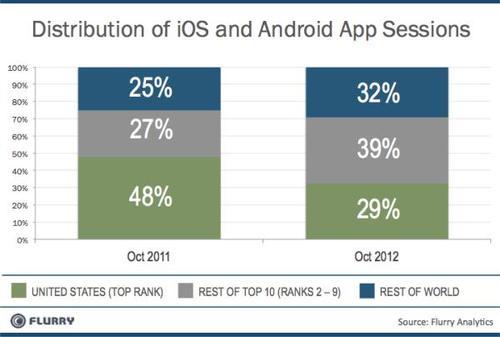Marshall McLuhan popularized the idea of the “global village” in the 1960s through his books The Gutenberg Galaxy: The Making of the Typographic Man and Understanding Media. McLuhan, who is credited with predicting the concept of the Internet decades before it actually existed, described the instantaneous movement of information from every quarter to every point at the same time, enabled by electric technology. The result is that the globe contracts into a village.
Post-Internet, the explosive adoption of iOS and Android smart devices best extends his theory. Enabled by this new computer-mediated platform is the distribution of apps, from every quarter to every point, at the same time. Consider that in the United States today, right now, teams from Finland, Japan, Israel and the UK share top grossing positions alongside U.S. teams in the iTunes App Store and Google Play. Today, in the top Chinese app stores, one can find American, French and Japanese companies alongside Chinese companies for a top share of revenue. And in the top UK app stores, companies from Serbia, Finland, Japan, China and the U.S. are counted among local UK companies as top revenue generators.
Welcome to the new global village built on a foundation, per Flurry’s count, of three quarters of a billion active iOS and Android smart devices, simultaneously running across more than 220 countries and territories that will generate revenue approaching $10 billion in 2012. This report focuses on the further shrinking of the global village, driven by the prolific spread of global smart devices over the last 12 months. We show which countries have the largest active smart device installed bases, are experiencing the fastest growth and how the distribution of app usage is shifting to become increasingly international. For its analysis, Flurry uses data from more than 250,000 applications that it tracks, running on more than 750 million devices worldwide. With its application coverage, Flurry estimates that it can reliably detect over 90% of all iOS and Android devices active in the world during a given month.
Let’s start by looking at which countries make up the world’s largest app markets.

The chart above shows the top markets by their active iOS and Android user bases during October 2012. The US and China tower over the next group of top markets by at least five times. And while the U.S. has added a whopping 55 million net active devices since October 2011, China has added a dizzying 125 million, a figure that totals the sum of the UK, Japan and South Korea’s combined, current active user base. Flurry predicts that China will surpass the U.S. in total installed base by the end of Q1 2013, delayed only by the upcoming massive holiday season that will spike the U.S. installed base.

The chart above shows the growth in active devices per country between October 2011 and October 2012. China leads the world with an impressive 293% year-over-year growth rate, spurred by the potent combination of its vast population and rapidly growing middle class. For this chart, Flurry selected countries that had a minimum of a half a million active devices as of October 2011. Compared to prior Flurry international growth studies, we note that a new set of fast-growers has now entered the top 10 including Colombia, Ukraine, Venezuela and the Philippines, further demonstrating the shrinking global village.

Lastly, we look at the volume of application usage across the globe tracked by Flurry, which we estimate comprise of approximately one fifth of all worldwide app sessions on iOS and Android, the world’s largest cross-platform sample. Year-over-year app sessions in the U.S. declined as a proportion of WW sessions between October 2011 and October 2012, from 48% to 29%. The balance of the top 10 (ranks 2 -9) grew from 27% in October 2011 to 39% in October 2012. The rest of the world also made gains from 25% in October 2011 to 32% in October 2012. In total, 71% of all app sessions now take place outside the U.S.
Over the last century, the distribution of the world’s information has migrated from print (e.g., books and newspapers) to mass media (e.g., radio and television) to computer-mediated media (i.e., the Internet). Over just the last five years, however, we’ve taken the most significant step forward in the evolution of media distribution with the unprecedented adoption of smartphones and tablets: portable, broadband-connected super computers connected to The Cloud. Applying McLuhan’s point of view that “the message is the media,” apps are the new message.